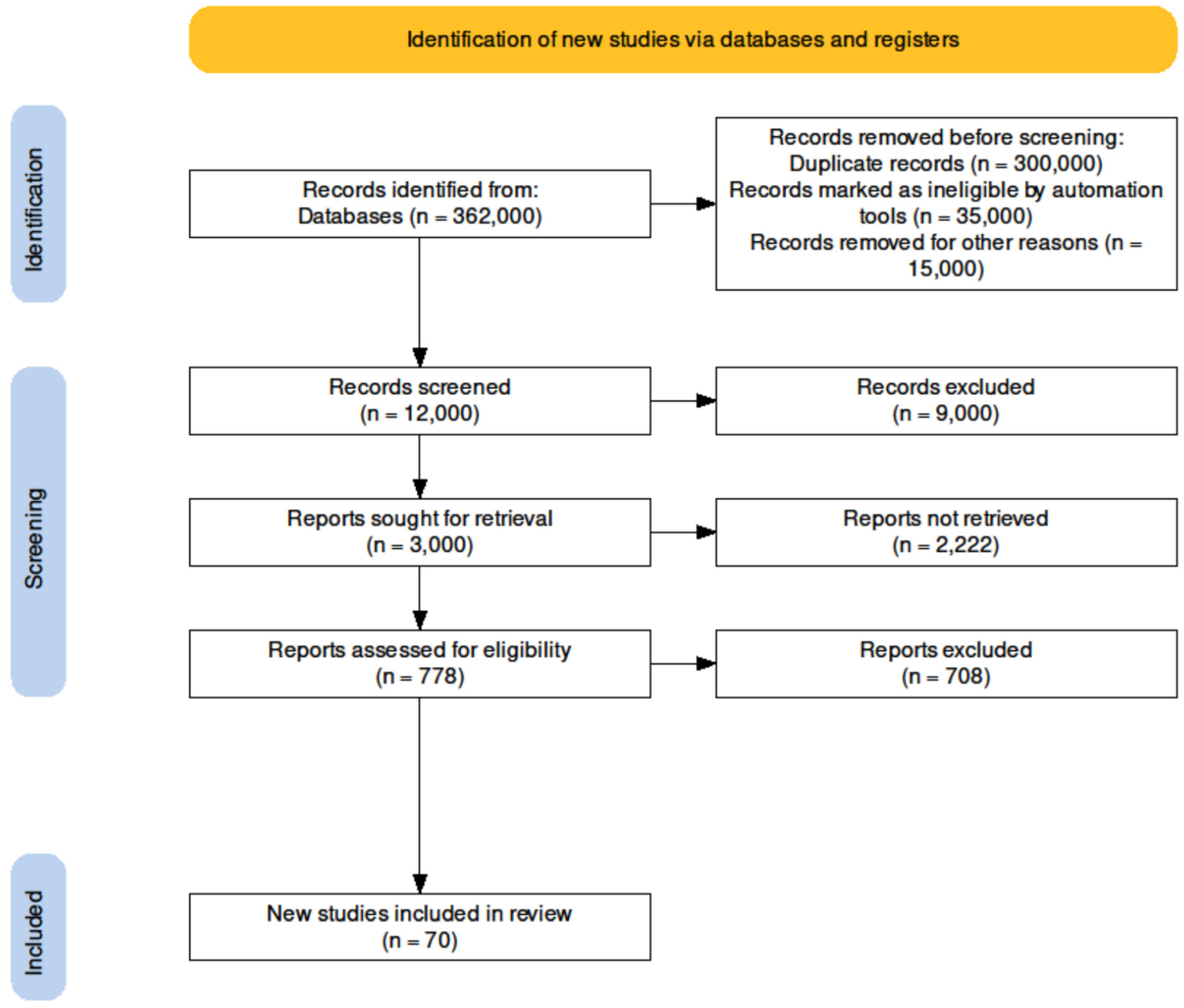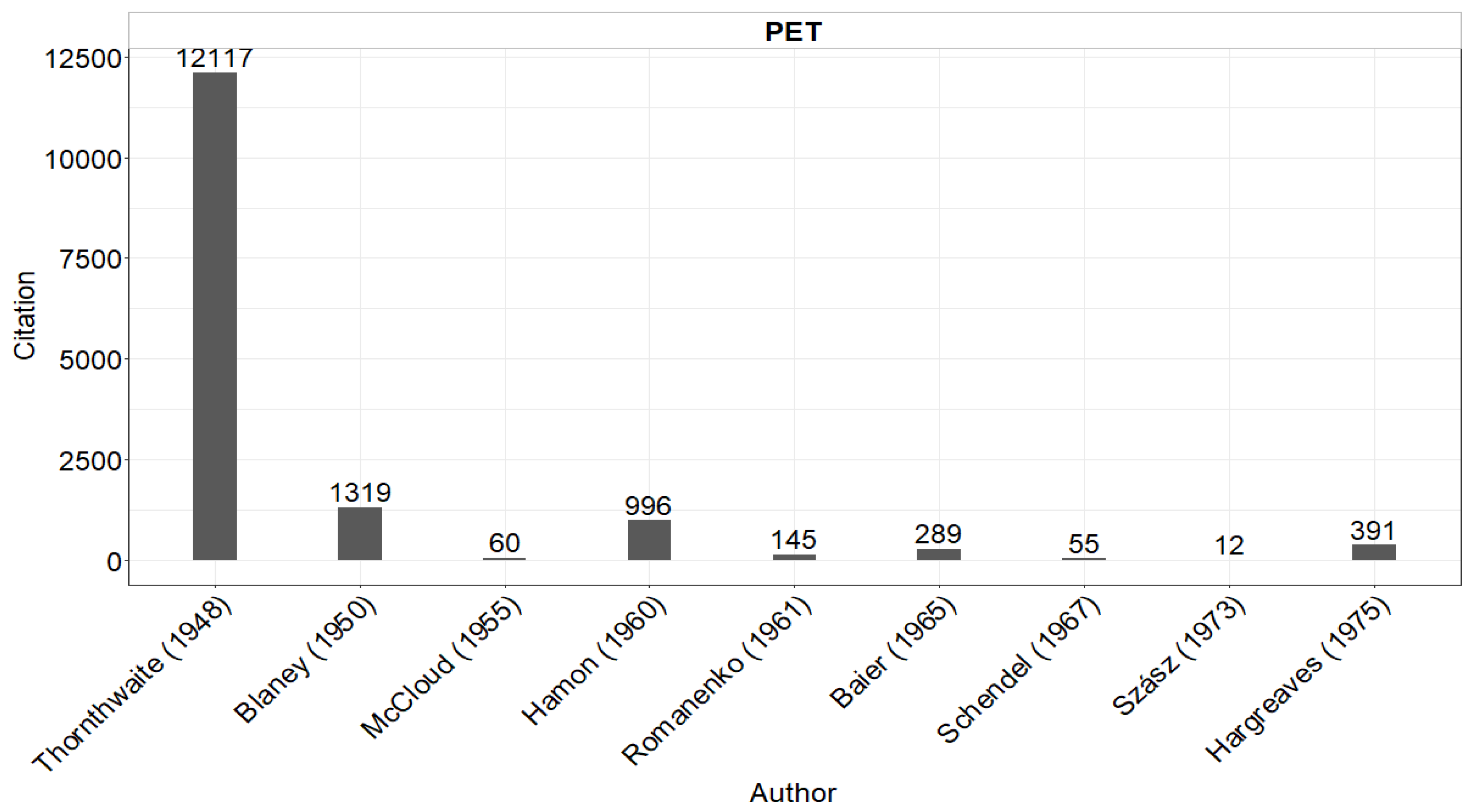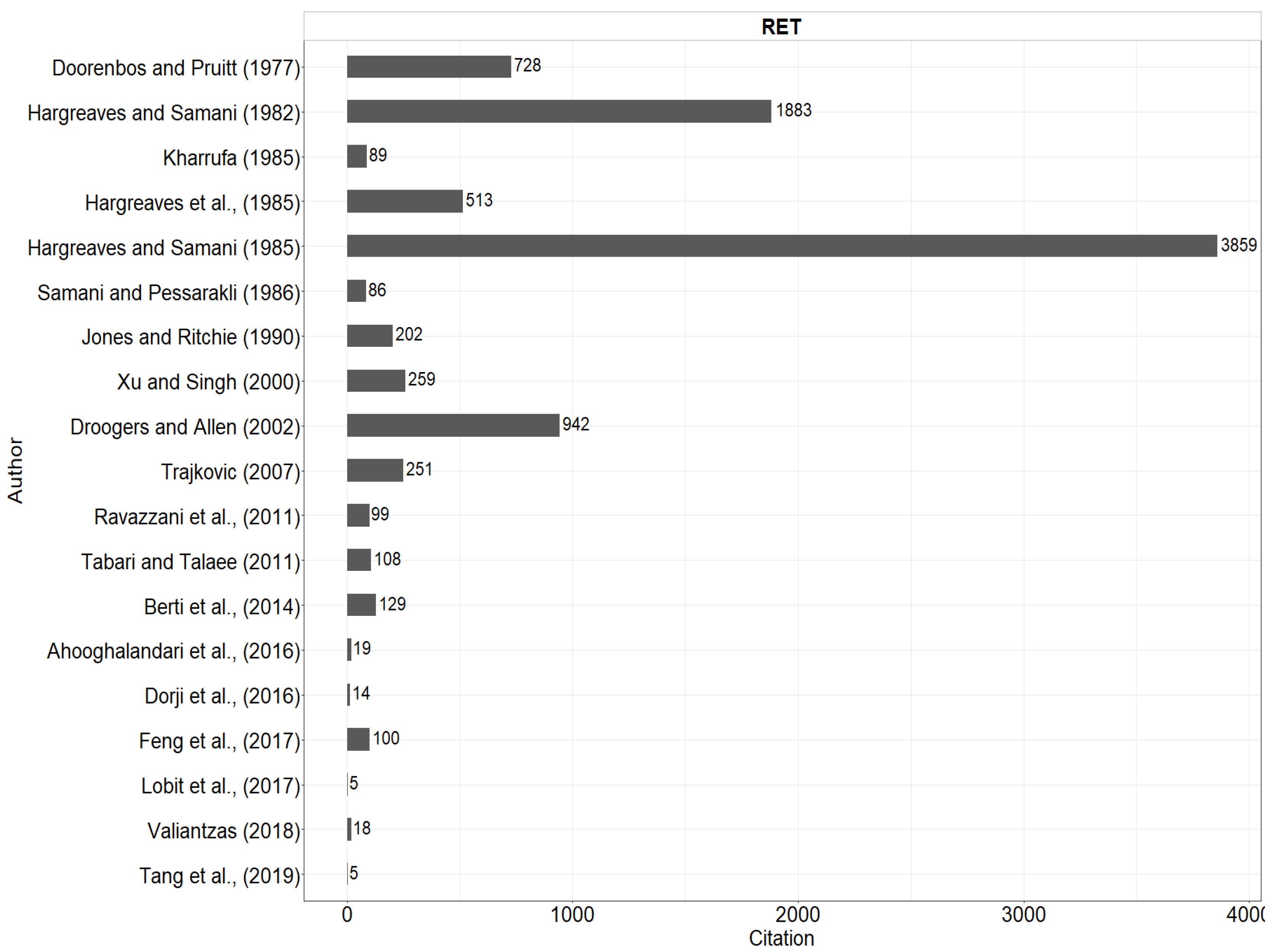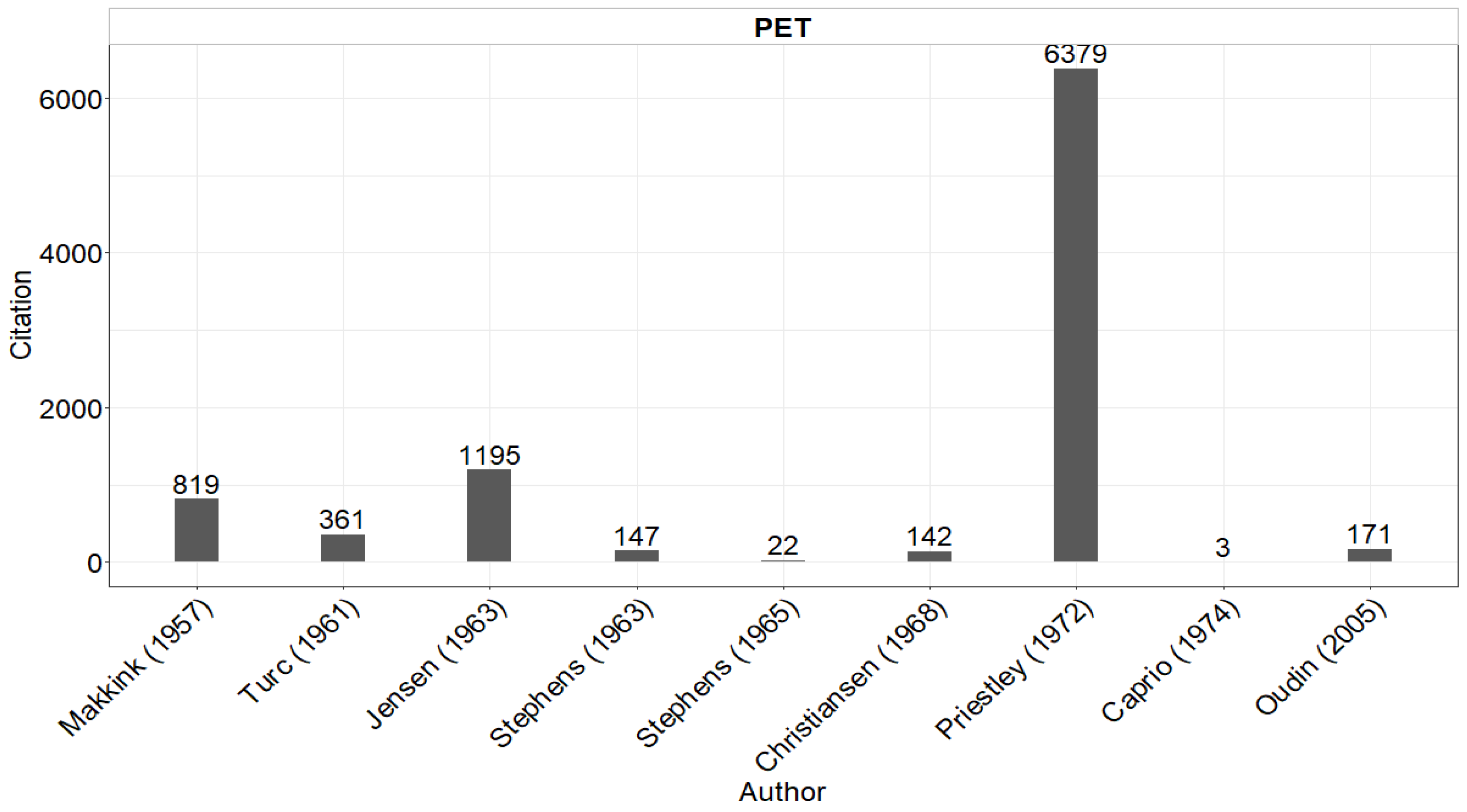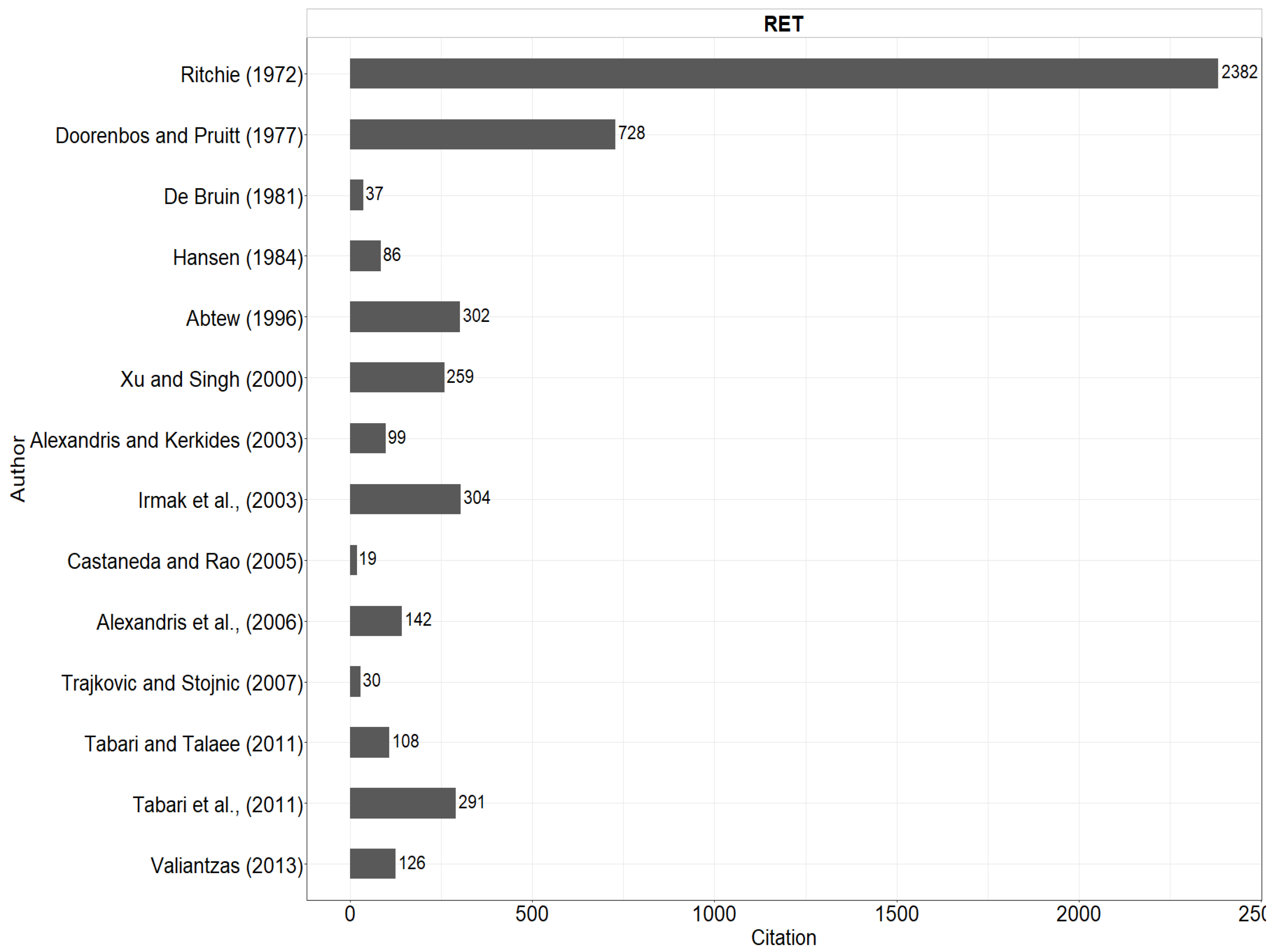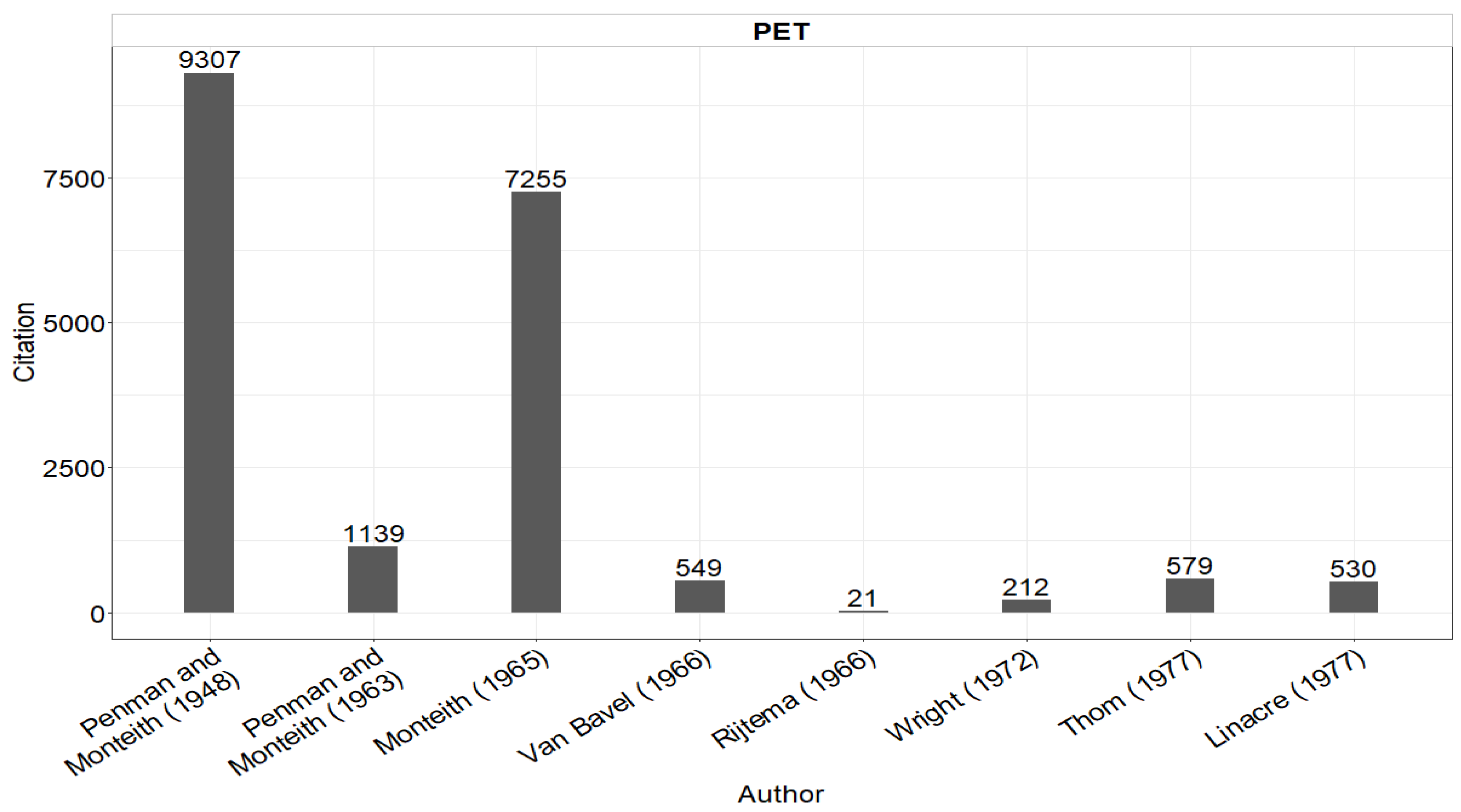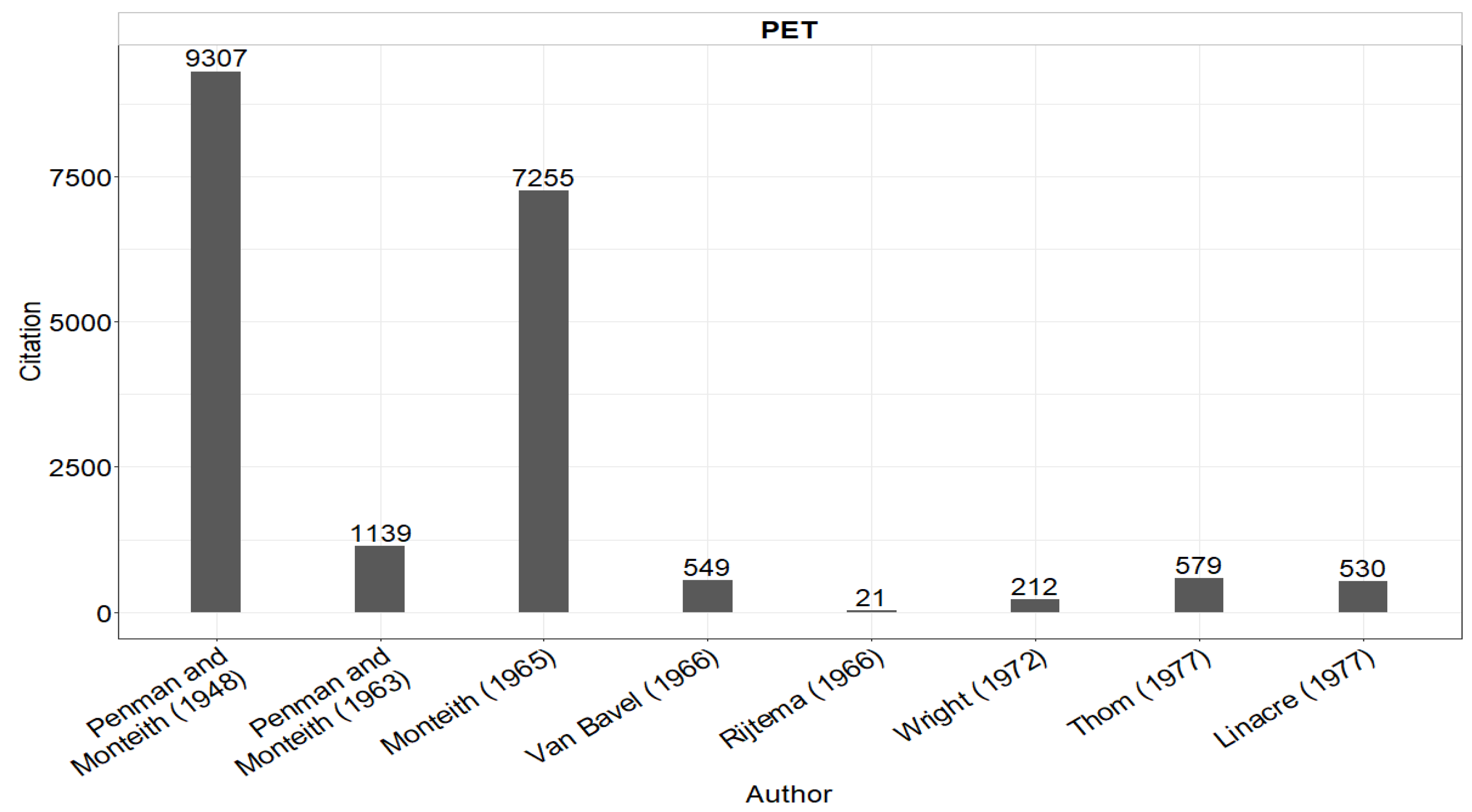1. Introduction
Evapotranspiration (ET) is a vital component of the water cycle and a useful indicator for several environmental studies [
1,
2,
3], including climate change research. It is difficult to quantify this climatic parameter because of the diversity of the interactions that occur at the soil–vegetation–atmosphere interface [
4]. Water evaporates from the soil surface and transpires from plants in a process known as ET [
5]. It is extensively used across a number of fields, including agronomy, hydrology, climatology, meteorology, ecology, and environmental science. Additionally, reference evapotranspiration (RET) and potential evapotranspiration (PET) are two interlinked notions. Although PET and RET both estimate the atmospheric evaporative demand, the terms may be distinguished since they are based on distinct theories and use different equations. For many years, there has been no consensus about PET and RET usage and application. According to the findings of the research, these two terminologies are identical [
5,
6,
7,
8]. Other studies used the terms PET and RET interchangeably and calculated them using similar formulas [
9,
10,
11,
12,
13]. The terms "PET" and "RET" were both used by Hargreaves and Samani in their research report, which was published in 1982 [
14]. In turn, this led to confusion among researchers on the proper use of PET and RET concepts.
According to Thornthwaite [
15], PET is the evapotranspiration from a large area of land that is covered with vegetation and has an unlimited moisture content. Since the moisture supply is unrestricted, he thought PET is completely reliant on the quantity of energy available. PET was defined by Penman [
16] as ET produced by actively growing short, green vegetation that completely shadows the ground and never lacks sufficient moisture. On the surface, PET may be conceived of as the aggregate of all climatic factors affecting the ET process. ET occurs when the soil is completely covered by living things that are actively developing and when there are no restrictions on the amount of moisture in the soil. It may be regarded as the absolute maximum that a crop can receive in a given climate.
The evapotranspiration rate of a hypothetical reference crop with an assumed crop height of 0.12 m, a constant surface resistance of 70 s/m, and an albedo of 0.23 is defined as the ET rate from a reference surface and denoted by RET [
5]. The reference surface resembles a broad swath of uniformly tall, actively growing grass that totally shadows the ground and has an infinite supply of soil moisture. RET provides data on atmospheric evaporation demands irrespective of crop development, growth stage, or management techniques. However, since soil water is easily available at the reference surface, the soil variables have no impact on the quantity of RET generated. When RET is connected to a specific surface, it offers a standard against which RET from other surfaces may be examined.
Additionally, climate factors influence RET. As a consequence, it might be determined using weather information. It should be emphasized that the RET definition stipulates that, for climatic data to be deemed legitimate, they must be collected in a well-defined environment, such as a grassy area that has been well-irrigated and maintained. Early uses of PET were in hydrology and meteorology, but it was eventually used in other disciplines. It was related to agricultural water needs and when to irrigate, for instance, in agronomy [
17,
18,
19,
20]. Due to the definition’s vagueness, PET was not always applied appropriately. By explicitly connecting single or dual crop coefficient approaches, agronomists started to apply the RET idea to irrigation scheduling, design, and ET estimation. The introduction of the RET idea helped to resolve a number of PET misapplication issues, although the use of the concept is still unclear to researchers [
21,
22].
A number of RET/PET equation methods have been proposed and divided into three groups: temperature-based, radiation-based, and combination-based equations. For instance, temperature-based equations try to balance water loss (evaporation) effects by incorporating average (mean of minimum and maximum) atmospheric temperature, precipitation, and water change in the hydrological cycle. The radiation-based equations try to balance the amount of incoming energy that is available to produce evapotranspiration (and sensible heat flux) from the surface, and some of them even try to include advective terms (which provide additional energy). In addition, a combination-based calculation takes into account both energy balance and aerodynamics, as the ET process involves transforming liquid water into vapor and then dispersing the vapor. The variables velocity and vapor pressure are two of the most important concepts in aerodynamics since they relate to mass-transfer theory. Air temperature and other environmental conditions are taken into account in this conventional combination type of equation.
The ambiguity between PET and RET as explained above motivates researchers to provide insightful references and clarify the concepts to assist researchers who may not correctly differentiate between PET and RET in their future studies. The current systematic review’s goal, then, is to identify the evolution of frequently used PET and RET equations and applications, along with conceptual differences. This review contributes to a better understanding of the distinctions between PET and RET.
3. Adopted Methodology
A bibliometric analysis as per the guidelines of Preferred Reporting Item for Systematic reviews and Meta-Analysis (PRISMA) was conducted in this study. According to the recommendations, the PRISMA flow diagram for a systematic review was successfully created using a freely available official tool named Shinyapp (weblink:
https://estech.shinyapps.io/prisma_flowdiagram/ accessed on 6 June 2022), which can be seen in
Figure 1. To understand the PRISMA flow diagram, the following points should be considered:
- (1)
Data source: Google Scholar, Science Direct, PubMed, and Clarivate Analytics Web of Science databases were used with the following title and keywords: reference evapotranspiration estimation equation, potential evapotranspiration estimation equation, evapotranspiration estimation.
- (2)
Article screening: Records found in the searched databases that were duplicates or irrelevant, that did not have full-text availability, or were inaccessible or written in languages other than English were excluded and removed from the identified records.
- (3)
Article inclusion: Only relevant and suitable articles that provided RET and PET estimation equations using a dataset of daily, monthly, or yearly timescales were included.
It can be observed in
Figure 1 that 362,000 records were initially identified when keywords and titles of RET and PET equations were searched in the Google Scholar, Science Direct, PubMed, and Clarivate Analytics Web of Science databases. The duplicate records were omitted, and about 12,000 were screened out from the total identified records as per content relevancy. Finally, based on the inclusion criteria mentioned above, 70 research articles were found to be suitable that provided the correct RET and PET estimation equations. In the current study, equations for RET estimation were retrieved from 44 research articles, whereas equations for PET estimation were collected from 26. The authors, timescales, and citations of the corresponding RET and PET equations are discussed in the next section.
3.1. Temperature Based Equations
PET equations may be traced back to Jensen et al. [
56]. They were among the earliest mathematical notations for estimating evapotranspiration based on temperature [
57]. Thornthwaite [
15] proposed a temperature-based PET equation after studying the relationship between precipitation, temperature, and water fluctuation in numerous states across the United States. Additional PET temperature-based equations have been proposed and implemented.
Table A1 illustrates the world’s most commonly used equations. From this table, it can be perceived that PET equations developed by McCloud [
58], Hamon [
59], Romanenko [
60], Baier and Robertson [
61], Schendel [
62], and Szász [
63] have been applied less than Thornthwaite and Blaney and Criddle’s equations [
15,
64]. Some of them, such as Szász and McCloud’s equations, were abandoned due to poor performance and unjustified or inadequate meteorological conditions. As observed in
Figure 2, Thornthwaite’s equation is widely used in research articles (12,117 citations), because it is simple and requires the least amount of data. Several researchers have also compared it to other equations and found that it performed best. Similarly, Blaney and Criddle’s equation has also been widely used as a reference in many studies (1319 citations) for predicting PET because of its performance and ease of data collection. Moreover, it was found to be suitable for humid conditions where the advective impact is generally insignificant.
RET temperature equations are essentially the same as PET temperature equations since both indicate a high demand for evaporation in the atmosphere. Most RET computations include numerous distinct coefficients, similar to how PET is modified.
Table A4 illustrates some of the most often used RET temperature-based equations. These equations can be difficult to distinguish from PET equations, and this is similarly true for the other forms of RET equations. Kharrufa’s equation [
65] performs poorly in various research studies under varying climatic circumstances, and it either overestimates or underestimates RET [
66,
67]. Hargreaves and Samani’s 1985 equation outperforms other equations developed by Hargreaves and Samani [
14] and Hargreaves et al. [
68], as it was cited in 3859 research articles, whereas the others were mentioned in 1883 and 513 articles, respectively. It is the most often used RET equation based on temperature data, as observed in
Figure 3.
3.2. Radiation Based Equations
Radiation-based PET equations show empirical relations between PET and radiation. These equations can be seen as Penman’s generalized versions [
16], and relatively accurate short-term predictions have been acquired [
36].
Table A2 presents some ordinary PET radiation equations. Priestley’s equation, developed in 1972, have been applied worldwide and are considered the most common radiation-based PET equation. As evident from
Table A2, it has supremacy over other developed PET radiation-based equations, with 6379 citations. It can also be seen in
Figure 4 that Priestley’s equation was cited many times compared to other PET equations. Moreover, this equation is suitable for saturated conditions and areas with open water surfaces with wind effects.
Widely applied RET radiation-based equations are similar to temperature-based PET equations.
Table A5 presents the commonly used RET-based radiation equations. Among the radiation-based RET equations, Ritchie’s equation [
69] received the most citations (2382), as seen in
Table A5, even though it was initially presented to estimate PET. Variability and instability still exist in radiation-based equations. Simultaneously, study results have demonstrated exemplary performance in semi-arid or semi-humid conditions, where the lack of wind speed data can be ignored. The overall citations for each RET equation are presented in
Figure 5. It can be seen that Ritchie’s equation has been cited more than other RET equations.
3.3. Combination-Type Equations
PET combination-based equations incorporate both energy balance and aerodynamic components. Moreover, velocity and vapor pressure are aerodynamic components related to Dalton’s theory of mass transfer presented in 1982. In 1948, Penman [
16] provided a PET combination equation that considers the influence of air temperature and other climatic conditions. However, its primary goal was to compute the water quantity escaping from sticky surfaces.
Table A3 shows some PET equations based on various combinations. It can be observed that the most often utilized combination-type PET equation is Penman’s equation, which was cited by 9307 studies. It is followed by Monteith [
70], cited by 7255 studies, and Penman–Monteith [
31], cited by 1139 studies. Penman’s [
16,
31] equations have not only been examined for diverse purposes but have also been changed for various situations by many researchers.
Moreover, Penman-type equations depend upon numerous meteorological variables that are not readily available in developing countries. As a result, other equations are frequently used as an alternative in these regions, with low PET accuracy being a predictable result. The citation of each PET combination-based equation is presented in
Figure 6.
When required hydro-meteorological data are available, RET combination equations, like those for PET, are widely used worldwide (see
Table A6). According to
Figure 7, the equation of Allen et al. [
5], also known as FAO-56 PM, was identified as the best for estimation using different step weather data (with >23,000 citations). This equation is a modified version of the Penman–Monteith equation, which was developed in 1965. FAO recommended it and it is widely used for various reasons, including its robust theoretical foundation and extensive depiction of the model [
50]. Thus, it is primarily used as a yardstick for different RET equations and novel approaches to evaluate their performance [
71,
72].
4. RET and PET Application
It should be noted that RET and PET equations as alternatives to the FAO-56 PM equation have previously been compared. RET and PET equations were properly distinguished from one another in this work. In earlier research, PET and RET were not clearly separated, and PET equations were often compared to the FAO-56 PM equation. Nonetheless, the authors did not address this, and the issue between PET and RET remains unresolved. Trajkovic and Kolakovic [
73] evaluated several PET equations with FAO-56 PM in humid climatic conditions, whereas Zarch et al. [
74] studied them under desert climate patterns. The only equation that accurately predicted RET among the others was that of Hargreaves and Samani [
75]. There were more cases of RET and PET equations being mixed together, and the two parts were often compared [
76,
77,
78,
79]
Ambiguity in RET and PET implementation equations has been widespread since solutions were often chosen at random. Both concepts derive from evaporation or evapotranspiration, which are used interchangeably. In meteorology, environmental science, and hydrology, PET has often been employed. Regarding agriculture, RET is the preferred method of irrigation. Thornthwaite’s equation [
15] of PET was employed in this context to estimate drought indicators such as Palmer drought intensity indices (SDIS). However, following the conventional RET equation assumption, the FAO-56 PM equation is often employed to estimate PET for the Palmer Drought Severity Index (PDSI) [
5]. PET is an important variable in several equations that are used to generate the A.I. drought index. Additionally, it is considered to be a crucial element in numerous hydrologic models that simulate precipitation and runoff [
80,
81,
82,
83,
84,
85]. Accurate RET calculations are necessary in agronomy to determine crop water needs and serve as the foundation for creating agricultural irrigation systems and other strategies. Surface resistance, stomata resistance, and diffusion resistance are only a few of the factors that are represented by the crop coefficient (Kc) [
86,
87,
88]. The three most common RET estimation methods that apply RET as their primary variable [
5,
88] are: (i) the single crop coefficient (RET = Kc × RET); (ii) the dual crop coefficient (RET = (Ka + Kb) × RET); and (iii) the Shuttleworth and Wallace method.
5. Conclusions and Guidelines for Future Use
Reference evapotranspiration (RET) and potential evapotranspiration (PET) are the two primary forms of evapotranspiration (ET). The misunderstanding between RET and PET has persisted for a very long time. Overall, RET and PET have been used interchangeably for a considerable time. Additionally, correctly distinguishing their meanings and applying them effectively provides an opportunity to improve ET estimation accuracy. Both RET and PET are applied to describe changes in energy and water, so they are related concepts. Despite having an evaporation (E) root, their respective meanings are quite distinct. To increase the investigation’s rationale, it is important to choose terminology that is appropriate for the variety of research related to ET topics. Furthermore, it is crucial to understand these two distinct concepts before using them properly. The definitions and uses of RET and PET differ, and they were designed for distinct timescales.
The Preferred Reporting Item for Systematic reviews and Meta-Analysis (PRISMA) was used in current study. RET estimation equations were obtained from 44 research publications, whereas equations for PET estimation were acquired from 26 articles. This study’s findings reveal that among temperature-based equations for PET, Thornthwaite’s (1948) equation was referenced in 12,117 papers, while Hargreaves and Samani’s (1985) equation was mentioned in 3859 studies. Similarly, Priestley (1972) had the most referenced equation (6379 citations) in radiation-based PET equations, while Ritchie (1972) had the most cited (2382) RET equation in radiation-based equations. Furthermore, Penman and Monteith’s (1948) equations were mentioned in 9307 research articles among PET combination-based equations, while the equation of Allen et al. (1998) received a substantial number of citations in more than 23,000 publications among RET combination-based equations. Based on application usage, PET is most commonly used in the domains of hydrology, meteorology, and climatology. However, RET is more commonly employed in the fields of agronomy, agriculture, irrigation, and ecology. PET has been utilized to calculate drought indicators, whereas RET has been used for single and dual crop coefficient techniques.
The RET and PET equations were previously frequently confused but, by the 1980s, they had been categorized into distinct types (temperature-based, radiation-based, and combination-based), which are explicitly explained in this study. RET aims to eliminate the uncertainties that occurred in the PET definition. Since its introduction, the RET idea has gained a large amount of support from researchers and scientists all across the world. The FAO56-PM equation has gained popularity and is now utilized for RET estimation globally. In the future, RET and PET should be distinguished more clearly from one another than they were in the past. Estimation formulae for PET and RET are the main cause of misunderstanding. This is because there is often a lack of clarity about the concepts and developments of PET and RET. The literature does not provide a clear structure for the many equations that can be used to determine RET or PET. The current study’s information is based on a common interpretation of these terms, which is useful for agricultural and irrigation engineers, farm managers, and university researchers because it provides clear direction for future usage.
